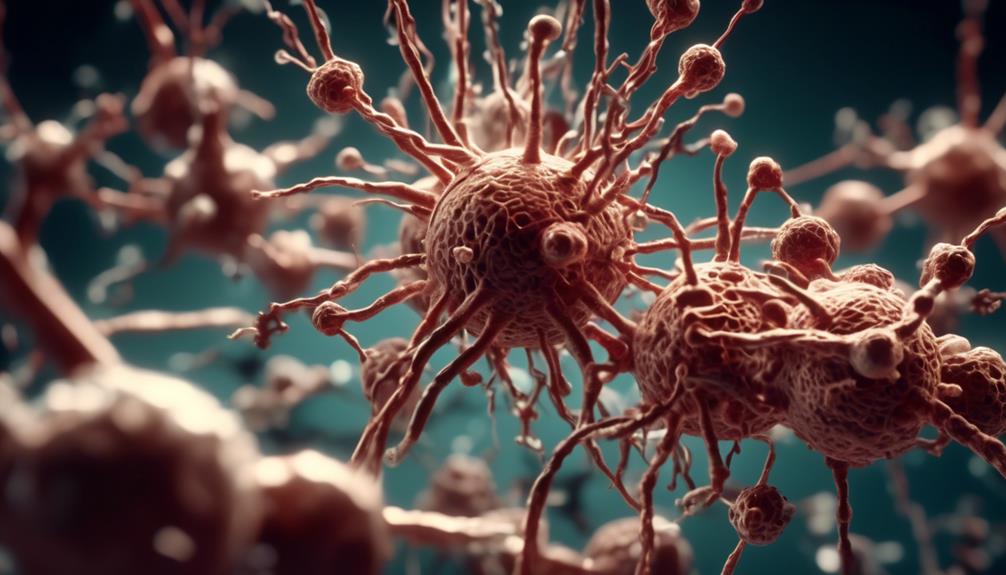Discovery of Autoimmune Disease Mechanism (1957) – Burnet: Recap and Summary: Theory of Autoimmunity Established

Burnet's groundbreaking discovery in 1957 established the theory of autoimmunity.
This discovery unraveled the mechanisms behind autoimmune diseases and provided crucial insights for their understanding and treatment.
Key Takeaways
- Burnet's clonal selection theory revolutionized our understanding of autoimmune diseases by challenging the belief that the immune system is unresponsive to self-antigens.
- The breakdown of self-tolerance is a key trigger for autoimmune responses, leading to the immune system attacking the body's own cells and tissues.
- Autoimmune diseases involve dysregulated immune responses, including the production of autoantibodies and imbalance in cytokine production.
- Genetic factors, environmental triggers, and dysregulation of immune checkpoints contribute to the development of autoimmune diseases.
Burnet's Groundbreaking Discovery
Burnet's groundbreaking discovery revolutionized our understanding of autoimmune diseases.
Sir Frank Macfarlane Burnet, an Australian immunologist, made significant contributions to autoimmune disease research in the mid-20th century. In 1957, he proposed the clonal selection theory, which provided a comprehensive explanation for the development of autoimmune diseases.
Burnet's theory stated that the immune system is capable of generating a diverse array of immune cells, each with a unique receptor. When an antigen enters the body, only the immune cells with receptors that specifically recognize the antigen are activated. These activated immune cells then multiply and mount an immune response against the antigen.
This theory was revolutionary because it challenged the prevailing belief at the time that the immune system was unresponsive to self-antigens. Burnet's research provided evidence that the immune system could indeed recognize self-antigens and potentially attack the body's own tissues, leading to autoimmune diseases.
Burnet's groundbreaking discovery paved the way for further research into autoimmune diseases and laid the foundation for our current understanding of how these diseases develop. His contributions have had a lasting impact on the field of autoimmune disease research, enabling the development of new diagnostic tools and therapeutic interventions aimed at managing these complex diseases.
Unraveling Autoimmune Mechanisms
With the foundation laid by Burnet's groundbreaking discovery, researchers have since unraveled the intricate mechanisms underlying autoimmune diseases. This knowledge has brought us closer to understanding how these diseases develop and progress.
Here are some of the key findings:
- Unexplained Triggers: Researchers have identified various triggers that can initiate an autoimmune response in susceptible individuals. These triggers can include viral infections, bacterial infections, environmental factors, and even certain medications. However, in some cases, the triggers remain unknown, leaving us with unexplained causes for autoimmune diseases.
- Genetic Predisposition: It has been established that there's a strong genetic component to autoimmune diseases. Certain genes are associated with an increased risk of developing these diseases. However, having these genes doesn't necessarily mean that an individual will develop an autoimmune disease. Other factors, such as environmental triggers, play a role in determining the onset and progression of these diseases.
- Dysregulated Immune Response: Autoimmune diseases occur when the immune system mistakenly attacks the body's own tissues and organs. Researchers have discovered that this dysregulated immune response involves a complex interplay between various immune cells, cytokines, and antibodies. Understanding these interactions is crucial for developing targeted therapies to modulate the immune response and restore immune system balance.
The Theory of Autoimmunity
Let's begin by exploring the theory of autoimmunity, which seeks to understand the mechanism behind self-attack in autoimmune diseases.
This theory suggests that the immune system malfunctions and mistakenly identifies the body's own cells and tissues as foreign invaders, leading to an immune response against them.
Evidence supports the idea that genetic factors, environmental triggers, and dysregulation of immune checkpoints contribute to this immune system dysfunction.
Mechanism of Self-Attack
The mechanism of self-attack in autoimmune diseases involves the immune system mistakenly targeting and attacking the body's own healthy cells and tissues. This phenomenon occurs when the immune system fails to recognize these cells as 'self' and instead identifies them as foreign invaders. The breakdown of self-tolerance, which is the immune system's ability to distinguish between self and non-self, plays a crucial role in triggering these autoimmune responses.
To investigate self-attack and self-tolerance breakdown, scientists have conducted extensive research. Here are three key findings:
- Genetic Factors: Certain genes have been identified as risk factors for autoimmune diseases. These genes influence the immune system's ability to properly recognize self from non-self.
- Environmental Triggers: Environmental factors like infections, toxins, and stress can trigger autoimmune responses in genetically susceptible individuals. These triggers can disrupt the immune system's tolerance mechanisms.
- Dysregulated Immune Response: Autoimmune diseases are characterized by an overactive immune response. This excessive immune activity leads to inflammation and tissue damage, contributing to the self-attack.
Understanding the mechanism of self-attack is crucial for developing effective treatments and interventions to restore self-tolerance and alleviate autoimmune diseases.
Immune System Malfunction
Immune system malfunction, also known as the theory of autoimmunity, explains the underlying mechanism behind the immune system's failure to distinguish between self and non-self, leading to the development of autoimmune diseases.
The immune system is responsible for protecting the body against foreign invaders, such as bacteria and viruses. It achieves this through a complex system of checks and balances, ensuring that it attacks only harmful substances.
However, in autoimmune disorders, this regulation breaks down, causing the immune system to mistakenly attack healthy cells and tissues. This malfunction occurs due to various factors, including genetic predisposition and environmental triggers.
When the immune system loses its ability to differentiate between self and non-self, it can lead to the development of autoimmune diseases, such as rheumatoid arthritis, lupus, and multiple sclerosis.
Understanding the immune system's regulation is crucial in developing effective treatments for autoimmune disorders.
Investigating Self-Tolerance Breakdown
Now it's time to delve into the investigation of self-tolerance breakdown and its role in causing autoimmune diseases.
Understanding the causes and mechanisms behind self-tolerance breakdown is crucial in unraveling the complex nature of autoimmune diseases.
Self-Tolerance Breakdown Causes
Understanding the causes of self-tolerance breakdown in autoimmune diseases is crucial for unraveling the complex mechanisms underlying these conditions. Several factors contribute to the breakdown of self-tolerance, including potential triggers and genetic factors. Here are three key factors to consider:
- Potential Triggers:
- Infections: Certain viral or bacterial infections can trigger an autoimmune response by mimicking self-antigens or causing inflammation.
- Environmental Factors: Exposure to certain chemicals, drugs, or toxins may disrupt immune tolerance and lead to autoimmune reactions.
- Stress: Chronic stress can impair immune function and increase the risk of self-tolerance breakdown.
- Genetic Factors:
- HLA Genes: Variations in the human leukocyte antigen (HLA) genes, which are involved in immune regulation, can increase susceptibility to autoimmune diseases.
- Genetic Mutations: Specific gene mutations can disrupt immune tolerance mechanisms and lead to the development of autoimmune disorders.
- Dysregulation of Immune Cells:
- Regulatory T Cells: Dysfunction or deficiency in regulatory T cells can result in the loss of self-tolerance and subsequent autoimmunity.
- B Cells: Abnormalities in B cell function, including the production of autoantibodies, can contribute to self-tolerance breakdown.
- Cytokines: Imbalance in cytokine production can disrupt immune regulation and promote the development of autoimmune diseases.
Mechanisms of Autoimmune Disease
Investigating the breakdown of self-tolerance in autoimmune diseases reveals intricate mechanisms underlying the development of these complex conditions. The immune response, which is usually responsible for defending the body against foreign substances, can mistakenly target the body's own cells and tissues in autoimmune diseases. This self-recognition failure is thought to occur due to a combination of genetic, environmental, and immunological factors.
To better understand the mechanisms involved, let's examine a 3-column, 4-row table:
| Mechanisms | Description | Examples |
|---|---|---|
| Molecular mimicry | Pathogens or foreign substances resemble self-antigens, leading to cross-reactivity and immune attack on self-tissues. | Rheumatic fever triggered by Streptococcus infection. |
| Loss of central tolerance | Failure in eliminating self-reactive T or B cells during their development in the thymus or bone marrow, respectively. | Type 1 diabetes due to destruction of insulin-producing beta cells. |
| Epitope spreading | Initial immune response against one self-antigen leads to the recognition and response against other self-antigens. | Multiple sclerosis progression from targeting myelin to other brain proteins. |
| Dysregulation of regulatory cells | Impaired activity or reduced numbers of regulatory T cells or B cells, resulting in unchecked self-reactive immune responses. | Systemic lupus erythematosus characterized by the production of autoantibodies. |
Understanding Immunological Memory
Immunological memory plays a crucial role in your body's defense against pathogens and is a key component of your immune response. Understanding how it works is essential in the field of immunological memory research and immune response regulation.
Here are three important factors to consider:
- Long-lasting protection: Immunological memory allows your immune system to remember previous encounters with specific pathogens. When you're exposed to a pathogen for the first time, your immune system mounts a primary response. During this initial encounter, specialized immune cells called memory cells are generated. These memory cells have the ability to 'remember' the pathogen, enabling a faster and more effective immune response if you encounter the same pathogen again in the future.
- Rapid response: One of the main advantages of immunological memory is its ability to mount a quicker and stronger immune response upon re-exposure to a pathogen. Memory cells can quickly recognize and target the specific pathogen, leading to a faster elimination of the invader. This rapid response is crucial in preventing the pathogen from causing severe illness or spreading throughout your body.
- Diversity and specificity: Immunological memory is highly specific and diverse. Each memory cell is programmed to recognize a particular pathogen. This diversity allows your immune system to remember and respond to a wide range of pathogens that you have encountered throughout your life. By maintaining a diverse pool of memory cells, your immune system can efficiently protect you against a variety of different pathogens.
Implications for Autoimmune Disease Treatment
The treatment of autoimmune diseases holds significant promise for improving patient outcomes and quality of life. With a better understanding of the mechanisms underlying autoimmune diseases, researchers have identified potential treatment options that aim to manage these conditions effectively.
One approach to autoimmune disease management involves suppressing the abnormal immune response responsible for attacking the body's own tissues. This can be achieved through the use of immunosuppressive drugs, such as corticosteroids and immunomodulators, which help to reduce inflammation and regulate the immune system.
Another promising avenue for treatment is the use of biologic therapies, which target specific components of the immune system involved in the autoimmune response. These therapies can block the action of certain immune cells or neutralize specific proteins that contribute to the disease process.
Additionally, researchers are exploring the potential of stem cell transplantation as a treatment option for autoimmune diseases. By replacing faulty immune cells with healthy ones, this approach holds promise for restoring normal immune function and alleviating symptoms.
While there's still much to learn about the treatment of autoimmune diseases, these potential options offer hope for improved outcomes and a better quality of life for individuals living with these conditions.
Impact on Future Research
What potential avenues for further research can be explored to deepen our understanding of autoimmune diseases and develop more effective treatments?
The discovery of the autoimmune disease mechanism in 1957 by Burnet has paved the way for significant advancements in immunology and has opened up exciting possibilities for future treatment approaches. Here are three key areas that hold promise for further research:
- Targeted Therapies: Current treatments for autoimmune diseases often involve broad immunosuppression, which can have significant side effects. Further research can focus on developing more targeted therapies that specifically modulate the immune response against self-antigens, while leaving the rest of the immune system intact. This approach has the potential to minimize side effects and improve treatment outcomes.
- Precision Medicine: Autoimmune diseases are highly heterogeneous, with different patients experiencing varying degrees of disease severity and response to treatment. By studying the genetic and molecular profiles of individual patients, researchers can identify specific biomarkers and develop personalized treatment strategies. This approach, known as precision medicine, has the potential to revolutionize autoimmune disease treatment by tailoring therapies to each patient's unique needs.
- Understanding the Role of the Microbiome: The human microbiome, which consists of trillions of microorganisms living in our bodies, has been shown to play a crucial role in regulating the immune system. Further research can explore the intricate relationship between the microbiome and autoimmune diseases, with the aim of identifying specific microbial species or products that contribute to disease development or progression. This knowledge can then be utilized to develop novel therapeutic approaches, such as targeted probiotics or microbiome-based interventions.
Burnet's Legacy in Autoimmunity Science
To fully appreciate the impact of Burnet's discovery of the autoimmune disease mechanism in 1957, it is essential to understand the lasting legacy he left in the field of autoimmunity science. Burnet's influence has paved the way for numerous breakthroughs in understanding and treating autoimmune diseases.
| Burnet's Influence | Autoimmunity Breakthroughs |
|---|---|
| Theory of Clonal Selection | Provided a framework for understanding how self-reactive immune cells contribute to autoimmune diseases. |
| Tolerance Mechanisms | Shed light on the mechanisms by which the immune system maintains self-tolerance and prevents autoimmune responses. |
| Experimental Models | Developed animal models that mimic human autoimmune diseases, enabling researchers to study disease mechanisms and test potential treatments. |
| Immunotherapy | Inspired the development of novel immunotherapies, such as monoclonal antibodies and immune checkpoint inhibitors, for the treatment of autoimmune diseases. |
Burnet's theory of clonal selection revolutionized our understanding of autoimmune diseases by explaining how immune cells can mistakenly attack the body's own tissues. This insight has guided research in identifying self-reactive immune cells and developing strategies to modulate their activity. Additionally, Burnet's investigations into tolerance mechanisms have elucidated the intricate processes that prevent the immune system from attacking self-antigens. This knowledge has led to the development of drugs that target these mechanisms to treat autoimmune diseases. Furthermore, Burnet's establishment of experimental animal models has allowed researchers to study autoimmune diseases in a controlled environment, leading to a deeper understanding of disease mechanisms and the testing of potential therapies. Lastly, Burnet's groundbreaking work in autoimmune disease paved the way for the development of immunotherapies that harness the immune system to target and destroy self-reactive cells. Overall, Burnet's legacy in autoimmunity science has been instrumental in advancing our understanding and treatment of autoimmune diseases, providing hope for millions of people affected by these conditions.
Frequently Asked Questions
What Were the Specific Autoimmune Diseases That Burnet's Discovery Helped to Understand?
Burnet's discovery helped you understand specific autoimmune diseases like Lupus and Rheumatoid Arthritis. These insights paved the way for better diagnosis, treatment, and understanding of the mechanisms behind these conditions.
How Did Burnet's Discovery Lead to Advancements in the Treatment of Autoimmune Diseases?
Burnet's discovery led to advancements in the treatment of autoimmune diseases by providing a foundation for understanding the underlying mechanisms. This knowledge has paved the way for targeted therapies and interventions, improving patient outcomes and offering hope for future breakthroughs in research.
What Were the Main Challenges and Obstacles Burnet Faced in His Research on Autoimmune Disease Mechanisms?
You faced numerous challenges and obstacles in your research on autoimmune disease mechanisms. One of the main challenges was understanding the complex interactions between the immune system and the body's own tissues.
Did Burnet's Theory of Autoimmunity Receive Immediate Acceptance and Recognition From the Scientific Community?
Burnet's theory of autoimmunity didn't receive immediate acceptance and recognition from the scientific community. However, its impact on medical research is undeniable, leading to advancements in understanding and treatment of autoimmune diseases.
How Has Burnet's Groundbreaking Discovery Influenced the Field of Immunology Beyond Autoimmune Diseases?
Burnet's groundbreaking discovery has revolutionized the field of immunology. Advancements in immunotherapy have been made, leading to improved treatments for various diseases. Additionally, his work has had a significant impact on transplantation research, enhancing success rates and patient outcomes.








